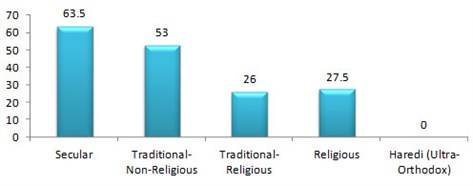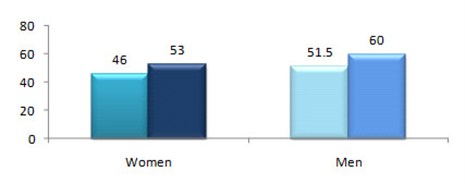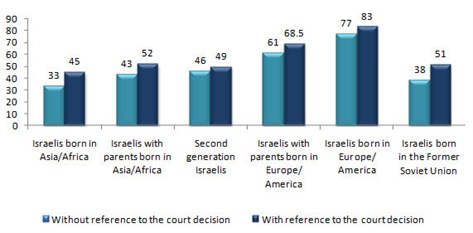Israeli Public Opinion on the Women of the Wall
Does the Israeli Jewish public support the right of the Women of the Wall to pray at the Western Wall while wearing prayer shawls and phylacteries? Who is more supportive of their struggle? Men or women? Secular, traditional, or religious Jews? IDI Senior Fellow Prof. Tamar Hermann shares findings from the April 2013 Peace Index.
Ever since 1988, the "Women of the Wall" have been waging a public and legal struggle to pray, read the Torah, and sing while wrapped in prayer shawls in the women's section of the Western Wall. Because of the recent prominence of this issue, the April 2013 Peace IndexThe Peace Index is a project of the Israel Democracy Institute and the Evens Program in Mediation and Conflict Resolution at Tel Aviv University. The survey was conducted by telephone on 28–30 April, 2013 by the Midgam Research Institute. The survey included 600 respondents, who constitute a representative national sample of the adult population aged 18 and over. The survey was conducted in Hebrew, Arabic and Russian. Maximum measurement error is ± 4.5% at a confidence level of 95%. Statistical processing was done by Ms. Yasmin Alkalay. surveyed Israeli public opinion on the right of these women to worship at the Western Wall in the way they see fit.
We asked: "Recently, there have been several clashes between the police and the Women of the Wall, a group of women who insist on their equal right to pray out loud at the Western Wall while wearing prayer shawls and phylacteries. To what extent do you support or oppose allowing the Women of the Wall to pray at the Western Wall as they see fit?" Public opinion in the Jewish public in general was divided, with a slightly stronger tendency to support the right of the Women of the Wall to pray as they wish (48%) than to oppose the group praying in this manner (38%).
A breakdown of the responses by the religious identification of respondents (based on their own self-definition) revealed the picture that one would expect. Support for Women of the Wall was high among self-defined secular Israeli Jews (63.5%) and among non-religious traditional Jews (53%) and was much lower among traditional-religious Jews (26%), religious Jews (27.5%), and Haredi Jews (0%):
Figure 1
Support for Women of the Wall by Religious Identification (%)

A breakdown by sex revealed the somewhat puzzling finding that support for Women of the Wall was slightly higher among Israeli Jewish men (51.5%) than among women (46%).
Figure 2
Support for Women of the Wall by Sex (%)

A breakdown by level of education indicated a disparity between respondents who have earned a university degree, of whom 57% support the right of the Women of the Wall to pray while wearing a prayer shawl and phylacteries, and respondents with lower levels of education. Among the latter group, support was 41% among respondents with some post-secondary education, 40% among high school graduates, and 41% among respondents with elementary school education and less.
Figure 3
Support for the Women of the Wall
By Education (%)

A breakdown of respondents by ethnic origins reveled a strong, significant difference between the support of Israelis with European and American origins—both Israelis who were born there themselves and Israelis whose parents were born there—and Israelis with other origins. Support for the Women of the Wall is highest among Israelis born in America or Europe (77%), followed by Israelis whose parents were born in America or Europe (61%), Israelis whose parents were born in Israel (46%), Israeli whose parents were born in Asia or Africa (43%), Israelis who were born in the former Soviet Union (38%), and Israeli who were born in Asia or Africa (33%). It is interesting to note that Israelis born in the former Soviet Union are actually more similar to Israelis of Asian-African origins than to Israelis of European-American origins when it comes to support for this issue.
Figure 4
Support for Women of the Wall
By Ethnic Origin (%)

We were interested in finding out what the effect of the District Court's decision that women's prayer in prayer shawls and phylacteries does not deviate from the accepted practice at the Western Wall and there is no justification for preventing the women from praying there. We therefore asked: "Now that the court has ruled that the prayer of the Women of the Wall does not violate the "custom of the place" and is not a criminal offense (and that there is no justification for preventing them from praying at the Western Wall plaza), in your opinion should they or should they not be allowed to pray there as they see fit?"
As shown in the figures below, the legitimacy that the Court gave to the prayers of the Women of the Wall served as "kosher certification," as it were, and strengthened support for their demands—albeit to a different extent—in each subgroup of the Jewish population, with the exception of respondents with elementary school education and less. In the Jewish public in general, support for allowing the women to pray as they see fit rose to 56%, while opposition declined to 34%. The rates of support within the Jewish sub-groups after the respondents were presented with the reference to the court decision were as follows:
Figure 5
Support for Women of the Wall
Without and With Reference to the Court Decision
By Religious Identification (%)

Figure 6
Support for Women of the Wall
Without and With Reference to the Court Decision
By Sex (%)

Figure 7
Support for Women of the Wall
Without and With Reference to the Court Decision
By Education (%)

Figure 8
Support for Women of the Wall
Wwithout and With Reference to the Court Decision
By Ethnic Origin (%)

In conclusion, the survey data show that support for the demand of the Women of the Wall to be allowed to pray at the Western Wall while wearing prayer shawls and phylacteries is not distributed evenly Israeli Jewish public, and is concentrated in Israelis who were born in Europe and America and their children (with the exception of Israelis born in the former Soviet Union), university educated Israelis, and traditional and secular Israelis. In contrast, support for the Women of the Wall is far lower among Israelis who were born in Asia and Africa, among Israelis with a low level of education, among religious Jews in Israel, and—even lower—among Haredim. Nevertheless, the District Court ruling regarding the legitimacy of the demands of the Women of the Wall significantly increased the level of support in almost all sub-groups of the Jewish population, suggesting that the Israeli public as a whole recognizes the court's authority to render an opinion even when it comes to matters related to religion
Prof. Tamar Hermann is a Senior Fellow at the Israel Democracy Institute, the Academic Director of IDI's Guttman Center for Surveys, and co-author of The Peace Index.
